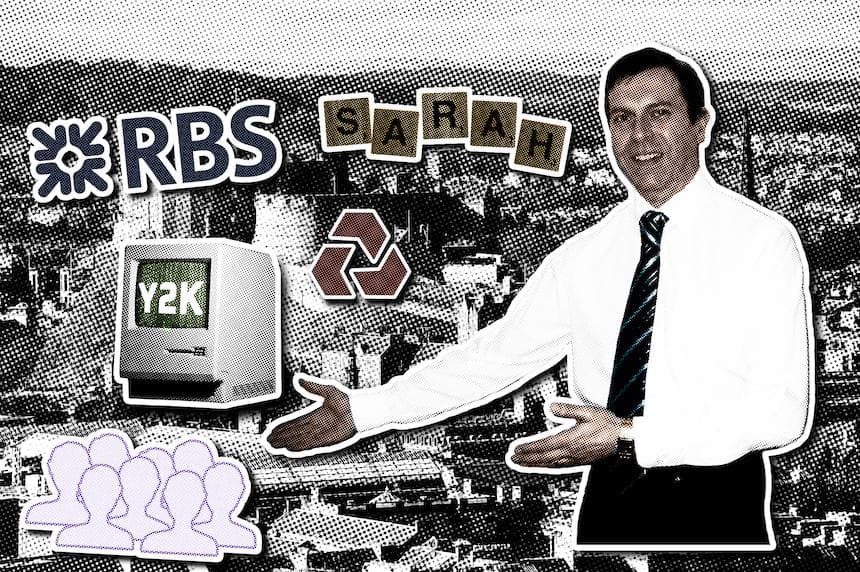A Leadership Journey: The Working Years (Part 4 - Production Implementation Team)

After the jubilation of RBS2GSI, attention returned to the work to get the NatWest business onto the GSI systems, along with the Group level operations. There was further churn in senior levels, most of which should feature in the stories of other leadership journeys, and not this one. For a short period, my role was mainly in support of others, such as Phil Brandom, who had been pulled out of a role managing one of the last of the leading-edge NatWest web development programmes, and asked to take the lead on delivering the mainframe-based, old technology, GSI test environments – a bit of an ask, so I completely understood when Dave Smailes asked me to help him. I learned a lot from that, as I watched how Phil went through what I later learned was the SARAH cycle in handling change:
- Shock – can’t believe this has happened
- Anger – how dare they do this to me
- Resistance – the current work is important, so someone will see sense and sort it
- Acceptance – looks like no one will see sense, and it’s going to happen
- Hope – this is the new future, and this work is a key part of it
I also gained a better understanding of the need for a leader to have a support team. Phil had several, and he brought them with him into the new environment team. Watching Phil operate gave me a better insight into effective delegation, and the importance of giving someone real ownership of the delegated activity, while retaining the accountability for it being done properly.
Alan Whelan had a heavy dependence on getting access to one of these environments, and had seen how the AIL I was building, along with the network of ISMs and Partition Managers were key to achieving this. My own journey took another small step at this time, while at the same time, gave me some insight into what I wanted to achieve – I was given an opportunity for higher profile and authority, and turned it down.
Alan and Tom Sartain were setting up a Testing Authority group, to have oversight on all aspects of testing, and I and the other Divisional Test Managers were invited. Alan tabled the idea of formalising the structure I had set up. He suggested I could take on a new role of “Chief ISM”. I felt this was not the right way forward – the structure I had was based around which systems were technically related to each other, regardless of which senior manager owned them. Ever since the start of NatWest Integration, there had been some jockeying at senior levels about who owned which systems, with several “changing hands” over the period. If the structure had been formalised, the question of senior ownership would have come to the forefront, and that would have been an obstruction to getting the job done.
The last reorganisation before the big migration in 2002 brought me into the Production Implementation Team (PIT), which was headed up by Duncan Millar. I can’t remember all the roles and structure, but I was still reporting to Dave Smailes, and he reported to Duncan. While work continued on the various stages of testing that had been formally agreed, I had become more convinced that the best approach should be based on the approach taken for RBS2GSI – to work out what we needed to do at the weekend when we cutover to run NatWest business on the GSI environment, then to run incrementally more extensive dress rehearsals of this. There was a lot of support for this in the PIT areas, which was mostly of RBS heritage, but – increasingly – amongst those from a NatWest background now working in PIT. I outlined a rough sequence of Proving Cycles (I think around 15) that would take us from a starting point to live. I handed this over to Steve Pavitt in the Strategy and Architecture team, who made it more presentable and started to fill in the details of duration and success criteria for each cycle. When Steve went on holiday. I took it back and completed the detail, and we now had a plan for the Proving Cycles.
The next part was outside of my awareness, but I was told by others that George Adams had taken the opportunity to present directly to Mark Fisher that we had a plan that was based on the same approach that had proved to be so successful on RBS2GSI, and while the other testing had its place, this was the key plan that would deliver Integration. I assume Duncan had briefed George, as they had always had a close working relationship in all the time I’d been at RBS. This taught me another lesson, about the importance of gaining the support of those who can influence the decision makers. I gather Mark agreed, and we got the resources to go ahead.
The plan was picked up and used by others to generate the level of detail required to execute and deliver it, and this is, again, where the contribution of others became crucial. Many of those who had been at the heart of the Command & Control processes for Y2K took on key roles at this stage. I became one of the 4 Target Execution Managers (the others being Linda Webster, Phil Brandom and Walter Thomson) that reported to Derek Tucker and were responsible for the daily execution of the plan once the NatWest data had been loaded onto the GSI systems. There is a brief summary of NatWest Integration that gives a sense of the scale of the Programme.
The October 2002 conversion referenced in that article was the BIC weekend (if memory serves, BIC stood for BOLP IMMAS Conversion – the conversion of the core domestic and international systems data).
There is much that could be said about that period, but the key thing in relation to a leadership journey was the growing understanding of the importance of working relationships in leadership. I wasn’t thinking about it at the time, but I can see now that some of the most effective leaders at that time – such as Derek Tucker – worked very hard behind the scenes to build and cement relationships. That played a much bigger part in my journey when we moved on from NatWest Integration and into the Group Value Programme, where I got the opportunity to make a noticeable impact on the RBSG cost:income ratio.
